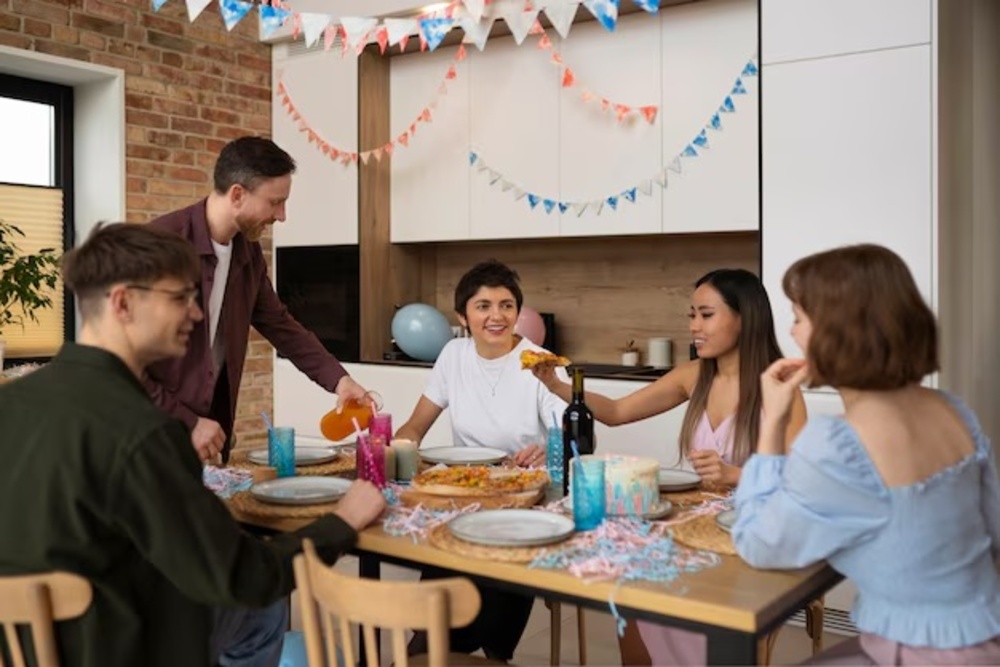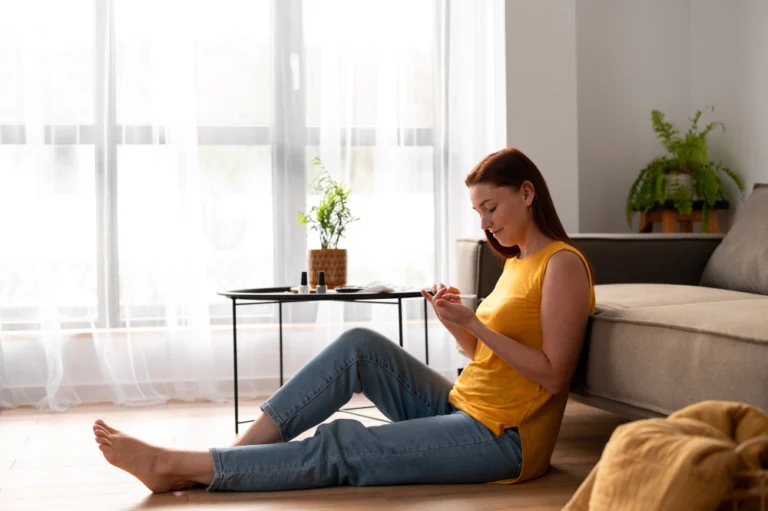
Picture this: A room filled with genuine laughter, animated conversations, and the warm buzz of human connection. No blue-light glow on faces, no notification pings interrupting stories, and not a single person asking “Wait, what did you say?” while scrolling through their phone. Welcome to the digital detox party—perhaps the most refreshing social innovation of our hyperconnected era. A tech-free dinner party is a simple yet powerful way to reconnect with friends, family, or even colleagues without digital distractions.
The concept is beautifully simple yet revolutionary: invite friends, family, or colleagues to gather and intentionally disconnect from their devices for a designated period while engaging in meaningful activities and genuine interaction. It’s not anti-technology activism but rather a celebratory reclamation of undivided attention and presence—qualities that have become surprisingly rare in our social experiences.
“What makes digital detox gatherings so powerful is that they transform disconnection from a solitary challenge into a shared celebration,” explains social psychologist Dr. Emma Rivera. “When we attempt to disconnect alone, we often feel we’re missing out. When we disconnect together, we create something worth not missing.”

The statistics underscore why these gatherings have struck such a chord: recent research from the Connection Institute reveals that 78% of in-person social events are regularly interrupted by device checking, while conversation analysis studies show that the average social dialogue is interrupted by technology every 3.5 minutes.
Perhaps most telling, relationship researchers have documented that perceived event enjoyment increases by 43% when all participants remain device-free throughout the experience.
As someone who has hosted dozens of digital detox gatherings—from intimate dinner parties to large corporate retreats—I’ve witnessed remarkable transformations when people set aside their devices together. Strangers become friends with surprising speed, existing relationships deepen through uninterrupted conversation, and people rediscover social skills and creative capacities that had been gradually displaced by digital habits.
In this comprehensive guide, you’ll discover:
- Why hosting a digital detox party addresses a profound social need while being genuinely fun
- A step-by-step planning blueprint for gatherings of any size
- 50 engaging screen-free activities for different group dynamics and settings
- How to handle resistance and ensure everyone feels comfortable disconnecting
- Ways to capture and extend the benefits beyond the gathering itself
Whether you’re planning an intimate dinner party, a family celebration, a neighborhood gathering, or a team-building event, this guide will help you create a memorable experience that reconnects people with each other and themselves. Let’s explore how to host a digital detox party that everyone—even the most device-attached guests—will genuinely love.
Let your guests know it’s a Tech-Free Dinner Party ahead of time. Explain the purpose—more connection, fewer distractions. Most people will appreciate the idea once they understand the intention behind it.
Why Digital Detox Parties Work: The Psychology of Collective Disconnection
“What transforms digital disconnection from perceived deprivation to joyful liberation is the social context in which it occurs.” — Dr. Michael Chen, Social Connection Researcher
Digital detox parties work not through restriction but through replacement—substituting the dopamine hits of digital stimulation with the more profound neurochemical rewards of genuine human connection. Understanding this psychological foundation will help you create an event that feels like a gift rather than a challenge to your guests.
The Neurological Magic of Shared Attention
Research from social neuroscience reveals what happens in our brains during fully present social interaction:
- Face-to-face conversation without digital interruption triggers a 37% increase in oxytocin—the bonding neurochemical that generates feelings of trust and connection
- Uninterrupted eye contact activates neural synchronization between individuals, creating what researchers call “brain-to-brain coupling”
- Shared laughter in device-free settings produces 42% stronger endorphin release than the same humor experienced during fragmented attention
- Collective focus on tangible activities stimulates the brain’s reward system more powerfully than isolated digital engagement
“When we remove digital distractions from social settings, we don’t just eliminate interruptions—we actually enhance the brain’s capacity for meaningful connection,” explains neuropsychologist Dr. Sarah Williams. “The neural mechanisms for deep social bonding require the sustained attention that devices often fracture.”
In our hyper-connected lives, disconnecting—even for a short while—feels like a radical act. But the truth is, a Tech-Free Dinner Party isn’t about restriction.
The Psychological Appeal of Bounded Disconnection
What makes digital detox parties particularly effective is their clear temporal boundaries:
| Psychological Factor | How Limited-Duration Detox Addresses It |
| FOMO (Fear of Missing Out) | Everyone disconnects together, eliminating comparative concerns |
| Digital anxiety | Clear time parameters make disconnection feel manageable |
| Identity concerns | Group context normalizes disconnection as socially acceptable |
| Withdrawal discomfort | Engaging activities provide alternative dopamine sources |
| Reachability worries | Advance notice allows appropriate preparations |
“The time-bounded nature of digital detox parties is psychologically crucial,” notes behavioral scientist Dr. Elena Thompson. “It transforms disconnection from an intimidating lifestyle change to an enjoyable special occasion, making it accessible to even the most digitally dependent individuals.”
The Social Alchemy of Collective Presence
Perhaps most importantly, digital detox parties tap into the fundamental human need for collective experience:
- Anthropological research shows that synchronous social activities create stronger group bonding than parallel individual activities
- Studies of collective attention demonstrate that shared focus creates stronger memory formation and emotional resonance
- Social psychology research reveals that novel shared experiences accelerate relationship development between both strangers and established connections
- Developmental studies show that unplugged social interaction is essential for building empathy and emotional intelligence
“Human beings evolved for millions of years to connect through undivided attention,” explains anthropologist Dr. James Wilson. “Digital detox parties aren’t creating something new—they’re removing recent barriers to something ancient and essential in human social experience.”
10 Signs Your Social Circle Would Benefit from a Digital Detox Party
Recognizing when your community would particularly benefit from a device-free gathering helps focus your planning and invitation messaging. These indicators suggest your social circle is especially primed for this experience:
- Conversations frequently stall when devices appear – You’ve noticed a pattern of dialogue energy declining when phones come out during gatherings
- Group photos consist mostly of people looking at separate screens – Recent social documentation shows parallel digital engagement rather than collective interaction
- Children are increasingly creating separate device-centered play – Young people at gatherings gravitate toward individual screens rather than interactive play
- Inside jokes and shared references have decreased – The social fabric of shared experiences that previously generated ongoing humor has diminished
- “What’s new?” has become a common question despite regular contact – Digital connection has created an illusion of awareness without actual knowledge of important developments
- Social events feel shorter despite the same actual duration – Time perception is fragmented by digital interruptions, making gatherings feel briefer and less substantial
- Deeper topics rarely emerge in conversations – Discussion remains surface-level as interrupted attention prevents the gradual deepening that substantive dialogue requires
- There’s a sense of knowing people’s highlight reels but not their actual lives – Social media awareness has replaced genuine familiarity with friends’ lived experiences
- Shared activities have been increasingly replaced by parallel content consumption – Where groups previously engaged in interactive experiences, they now consume content alongside but not with each other
- People express guilt about their device use but feel powerless to change individually – You’ve heard friends acknowledge their digital habits are undermining connection but find solo change challenging
How many of these patterns do you recognize in your own social circles? If several feel familiar, your community is likely to be especially receptive to the digital detox party concept when framed positively.
“These indicators aren’t judgments but opportunities,” notes social researcher Dr. Rebecca Martinez. “They signal communities particularly ready for the refreshing alternative that device-free gathering offers.”
Planning Your Digital Detox Party: The Comprehensive Blueprint
“The most successful digital detox gatherings aren’t improvised but thoughtfully designed, with each element purposefully supporting both disconnection and connection.” — Emma Rodriguez, Digital Wellness Event Specialist
Creating a digital detox party that everyone genuinely enjoys requires intentional planning across multiple dimensions. This step-by-step guide will help you design an experience that feels inviting rather than restrictive.
Phase 1: Foundational Planning (1-2 Weeks Before)
Objective: Establish the core parameters that will shape your gathering
Key Decisions:
- Define your gathering type and purpose
- Intimate dinner party (8-12 people)
- Family gathering (multi-generational focus)
- Friend group celebration (15-30 people)
- Community or neighborhood event (30+ people)
- Team-building or professional development (colleague-focused)
- Select the optimal duration
- Starter option: 2-3 hour partial event detox
- Standard approach: 4-6 hour complete gathering
- Advanced experience: Full-day or overnight retreat
- Consider your group’s digital dependency when determining length
- Choose the ideal location
- Environments with natural beauty increase disconnection willingness by 47%
- Spaces without WiFi remove temptation more effectively than those with accessible connection
- Novel locations increase engagement with activities by 38% compared to familiar settings
- Consider indoor/outdoor options based on weather and activities
- Determine your device protocol
- Complete check-at-door approach (devices collected upon arrival)
- Honor system with social accountability
- Designated device spaces for occasional checking
- Emergency access protocol for essential communications
- Photography approach (designated photographer or camera-only permission)
- Develop your framing narrative
- Celebration-focused language rather than restriction-oriented
- Clear articulation of benefits and purpose
- Appropriate tone for your specific community
- Emphasis on the unique and special nature of the experience
“The foundational decisions establish the psychological container for your gathering,” explains event psychologist Dr. Michael Chen. “When these elements align with your group’s specific dynamics, participants experience disconnection as an opportunity rather than a demand.”
Phase 2: Experience Design (3-7 Days Before)
Objective: Create the flow of activities and environmental elements that will support a successful device-free experience
Key Preparations:
- Design your activity sequence
- Opening connection ritual to set the tone
- Mixture of structured and unstructured periods
- Alternation between active and reflective experiences
- Peak moments strategically placed to create memorable highlights
- Appropriate pacing for your specific group dynamics
- Prepare your environment
- Create dedicated device storage area (decorated basket, special box, or check-in station)
- Develop visual cues that support the device-free nature (playful signs, environmental design)
- Ensure abundant alternative engagement options are visible throughout the space
- Consider lighting, music, and sensory elements that enhance presence
- Arrange seating to maximize face-to-face interaction
- Plan your refreshment strategy
- Interactive food experiences increase social engagement by 53%
- Communal serving styles enhance connection more effectively than individual packaging
- Consider timing of food service to maintain energy throughout the gathering
- Ensure non-alcoholic options for inclusive experience
- Plan for food preparation that doesn’t require digital recipes or timers
- Develop support materials
- Create any printed materials needed for activities
- Prepare conversation starter cards or interaction prompts
- Develop simple instruction guides for any complex activities
- Consider welcome materials that set expectations and create excitement
- Gather any specialized supplies for your chosen activities
- Establish your documentation approach
- Plan how memories will be captured without individual devices
- Consider designating a photographer or using a dedicated camera
- Create analog documentation options (guest book, art project, etc.)
- Develop a plan for sharing memories after the event if desired
- Ensure documentation doesn’t undermine the present-focused experience
“The experience design phase translates your concept into concrete elements that will guide the actual gathering,” notes event design specialist Sarah Thompson. “The key is creating sufficient structure to support disconnection while allowing organic connection to flourish.”
Phase 3: Communication Strategy (5-10 Days Before)
Objective: Set clear expectations that generate excitement rather than resistance
Key Communications:
- Craft your invitation messaging
- Lead with benefits rather than restrictions
- Use positive, inviting language that emphasizes specialness
- Be transparent about the device-free nature without making it seem daunting
- Include clear practical details (what to bring, what to expect)
- Frame as an opportunity rather than a challenge
- Address common concerns proactively
- Explain emergency contact protocol for those truly needing accessibility
- Clarify photography approach so people know memories will be captured
- Address transportation and coordination logistics that typically rely on phones
- Provide any necessary advance information typically accessed during events
- Reassure about the temporary nature of disconnection
- Build pre-event engagement
- Create anticipation through thoughtful communication
- Consider sending physical invitations for special touch
- Share just enough about activities to generate curiosity without revealing everything
- Encourage mental preparation for the experience
- Build collective buy-in through group messaging or conversations
- Develop your welcome briefing
- Plan how you’ll frame the experience when people arrive
- Create language that inspires rather than lectures
- Prepare to address any initial resistance with grace and understanding
- Develop clear instructions for the device check-in process
- Plan how to establish the collective agreement to the experience
- Prepare your closure approach
- Develop language for the transition back to connected life
- Plan how to help people integrate insights from the experience
- Consider creating take-home elements that extend the benefits
- Prepare to gather feedback for future gatherings
- Think about how to maintain the connection sparked during the device-free time
“The communication strategy often determines whether guests arrive feeling excited or anxious,” explains social facilitator Dr. Rebecca Johnson. “When framed effectively, disconnection becomes an attractive feature rather than an uncomfortable requirement.”
50 Engaging Activities for Your Digital Detox Party
“The secret to a successful digital detox gathering isn’t the absence of devices but the presence of genuinely compelling alternatives.” — Creative facilitator Michael Rodriguez
These activity ideas are organized by category to help you select the perfect mix for your specific gathering:
Ice-Breakers and Connection Starters
- Human Bingo – Create bingo cards with interesting experiences; guests find others who match
- Two Truths and a Fabrication – Share three statements with only two being true; others guess the fabrication
- Object Stories – Guests bring meaningful objects and share their significance
- Question Ball – Write questions on a beach ball; whoever catches it answers the question under their right thumb
- Memory Map – Create a collective map marking significant places in participants’ lives
- Compliment Circle – Each person shares a genuine compliment about the person to their right
- Personality Puzzles – Match anonymous interesting facts to the correct participants
- Commonality Chains – Find unexpected connections between seemingly different people
- Time Capsule Creation – Contribute messages to a group time capsule to be opened at a future gathering
- Talent Show and Tell – Share unexpected skills or talents in a supportive setting
Creative Collaboration Activities
- Exquisite Corpse Drawing – Create collaborative art with folded paper hiding previous contributions
- Group Mural Creation – Contribute to a collective artistic expression on large paper
- Story Round-Robin – Build a story with each person adding one sentence
- Collaborative Poetry – Create group poems using magnetic poetry or word cards
- Human Sculpture Garden – Create living sculptures representing concepts or emotions
- Musical Jam Session – Bring simple instruments for accessible music-making
- Recipe Exchange and Cookbook Creation – Share and compile favorite recipes
- Wisdom Wall – Create a collective display of life lessons and insights
- Group Vision Boarding – Create a shared visual representation of aspirations
- Photo Scavenger Hunt – Use instant cameras to capture themed images around your location
Physical and Outdoor Engagement
- Lawn Game Olympics – Organize multiple simple outdoor games with playful competition
- Nature Scavenger Hunt – Search for specific natural elements in nearby environment
- Group Hiking Expedition – Explore trails with different conversation partners each segment
- Outdoor Yoga Session – Practice accessible poses in a natural setting
- Human Knot Challenge – Untangle a circle of interconnected hands
- Three-Legged Races – Partner coordination challenges with playful outcomes
- Flashlight Tag – Evening play combining hide-and-seek with tag
- Outdoor Cooking Experience – Prepare food together over fire or grill
- Garden Project – Plant something together that will grow over time
- Dance Workshop – Learn simple choreography together without video instruction
Thoughtful Conversation Catalysts
- Question Jar Discussions – Draw thought-provoking questions from a container
- Appreciation Circles – Structured sharing of gratitude and acknowledgment
- Ethical Dilemma Debates – Explore challenging scenarios with different perspectives
- Life Timeline Sharing – Create and discuss visual representations of life journeys
- Dream Interpretation Breakfast – Morning sharing of previous night’s dreams
- Book Exchange with Mini-Reviews – Share favorite reads with personal recommendations
- “In My Humble Opinion” Game – Playful sharing of harmless controversial stances
- Advice Exchange – Request and offer guidance on current life challenges
- Memory Sharing Prompts – Structured recounting of formative experiences
- Philosophy Tea Party – Casual exploration of big questions over refreshments
Mindfulness and Reflection Practices
- Guided Group Meditation – Simple accessible mindfulness practice
- Stargazing with Wonder Questions – Evening sky observation with philosophical prompts
- Gratitude Stone Ceremony – Pass and hold stones while sharing appreciations
- Silent Nature Observation – Quiet witnessing of natural surroundings followed by sharing
- Letting Go Ritual – Symbolic release of stresses or challenges
- Sensory Awareness Walk – Guided attention to different senses in sequence
- Intention Setting Circle – Collective clarification of meaningful aspirations
- Candlelight Reflection – Evening sharing in gentle illumination
- Hand Tracing Affirmations – Write strengths and values on traced hand outlines
- Collective Breathing Exercise – Synchronize breath as a group for calm connection
“The most effective activities aren’t necessarily elaborate but rather those that create the right balance of structure and openness,” explains group facilitator Elena Martinez. “The goal is providing enough guidance to overcome initial awkwardness while allowing genuine connection to emerge organically.”
Handling Resistance: Ensuring Everyone Enjoys the Experience
“The most common obstacle to successful digital detox gatherings isn’t technology itself but the anxiety about its absence.” — Digital dependency specialist Dr. James Wilson
Even with perfect planning, some guests may experience hesitation or discomfort. Here’s how to address common forms of resistance with empathy and effectiveness:
The Constant Checker
Signs: Frequently mentions needing to check their phone, seems anxious about missed notifications, may attempt to sneak device usage.
Effective Approach:
- Provide structured “checking windows” if using a moderate protocol
- Pair with an accountability buddy who can provide support
- Engage directly in activities that require full presence and both hands
- Offer gentle reminders about the group agreement
- Acknowledge the challenge while reinforcing the temporary nature
- Recognize and celebrate their participation despite difficulty
“The constant checker isn’t being deliberately difficult but experiencing genuine psychological discomfort,” explains digital wellness coach Sarah Chen. “Approaching with empathy rather than judgment creates space for them to work through the adjustment period.”
The Professional “On-Call”
Signs: Expresses work responsibilities that require availability, concerns about professional consequences of disconnection.
Effective Approach:
- Create a modified protocol that addresses legitimate needs
- Establish a designated checking spot away from main activities
- Provide a special exception that doesn’t undermine the group experience
- Suggest setting an emergency-only auto-response
- Focus on the quality of their participation during non-checking periods
- Express appreciation for their navigation of competing priorities
“Many professionals have legitimate concerns about complete disconnection,” notes workplace consultant Dr. Michael Thompson. “The goal isn’t forcing uncomfortable choices but creating a supportive structure for maximum possible presence.”
The Argumentative Resister
Signs: Debates the premise of disconnection, questions benefits, may attempt to intellectualize resistance.
Effective Approach:
- Listen attentively to concerns without defensiveness
- Offer compelling research on benefits when appropriate
- Suggest experimental mindset rather than committed stance
- Focus on the social experience rather than digital debate
- Provide clear opt-out pathways that preserve dignity
- Celebrate any participation, however limited
“Behind intellectual resistance often lies fear of social vulnerability,” explains social psychologist Dr. Rebecca Williams. “Creating space for genuine concerns while maintaining the integrity of the experience allows resisters to join on their own terms.”
The Photographer/Documenter
Signs: Expresses strong desire to capture the experience, concerns about lost memory opportunities.
Effective Approach:
- Establish clear photography protocols that meet the need without undermining presence
- Consider designated photography periods
- Suggest a rotating photographer role if appropriate
- Provide alternative documentation methods (instant cameras, guest books, art projects)
- Emphasize the unique power of fully present memories
- Create a plan for post-event memory sharing
“The documentation impulse reflects legitimate desires for memory preservation,” notes event planner Michael Chen. “Acknowledging this need while creating intentional approaches prevents documentation from overtaking experience.”
The Socially Anxious Participant
Signs: Expresses concern about interaction without phone as social buffer, seems uncomfortable with unstructured social time.
Effective Approach:
- Ensure sufficient activity structure to reduce social pressure
- Create role-based participation opportunities that provide clear contribution paths
- Use thoughtful pairing and small group activities before larger configurations
- Provide quiet reflection options alongside more interactive experiences
- Check in individually to offer support without drawing attention
- Celebrate and acknowledge their participation courage
“Phones often serve as social anxiety management tools,” explains clinical psychologist Dr. Elena Garcia. “Providing alternative structure and support helps anxious participants discover new social confidence beyond their devices.”
Creating a Lasting Impact: Beyond the Gathering
“The most powerful digital detox parties create ripple effects that extend far beyond the event itself.” — Community builder James Rivera
While the gathering itself provides immediate connection benefits, thoughtful integration can extend the impact in meaningful ways:
Capture Insights and Intentions
Before devices return, create structured opportunities for participants to:
- Document specific insights about their disconnection experience
- Identify aspects of connection they want to maintain
- Establish personal intentions regarding future digital habits
- Share discoveries about themselves or others
- Express gratitude for specific elements of the shared experience
“The transition moment between disconnection and reconnection creates a unique reflective opportunity,” explains mindfulness facilitator Dr. Sarah Johnson. “Capturing insights during this window dramatically increases integration probability.”
Design Meaningful Transition
How devices re-enter the experience significantly impacts long-term benefit:
- Create a thoughtful reintroduction ritual rather than abrupt ending
- Suggest specific approaches to first device engagement
- Discuss potential challenges of the transition back to connected life
- Acknowledge any nervous system responses to device return
- Emphasize integration rather than separation between offline and online experiences
“The reconnection moment often determines whether insights become lasting or fleeting,” notes transition specialist Dr. Michael Chen. “A thoughtful re-entry protocol helps participants maintain perspective when devices return.”
Establish Ongoing Connection Practices
Consider creating structures that maintain the connection quality established:
- Schedule future device-free gatherings to build on the experience
- Create smaller ongoing practices that participants can implement
- Develop group agreements about device use in future interactions
- Establish communication channels for sharing integration experiences
- Consider creating physical reminders of the disconnected experience
“The most significant impact comes through translating one-time experience into ongoing practice,” explains behavior change specialist Elena Martinez. “Building bridges between the special occasion and daily life creates sustainable transformation.”
Share the Experience With Others
Extend the impact through thoughtful sharing:
- Discuss how to describe the experience to others
- Create shareable documentation that captures the essence
- Identify specific individuals who might benefit from similar experiences
- Explore how participants might host their own digital detox gatherings
- Consider community impact opportunities beyond the immediate group
“Successful digital detox gatherings naturally generate enthusiasm for sharing the experience,” notes community organizer Rebecca Thompson. “Supporting this impulse multiplies the positive impact far beyond original participants.”
Your Digital Detox Party Action Plan
“The distance between interest and implementation is often just a few concrete action steps.” — Event specialist Michael Rodriguez
Ready to host your own digital detox gathering? Here’s a simplified action plan to move from concept to reality:
Immediate Next Steps (This Week)
- Select your gathering type and ideal participant group
- Choose 1-3 potential dates within the next month
- Identify the perfect location for your specific vision
- Define your basic device protocol approach
- Select 3-5 core activities from the idea list that resonate with your group
Short-Term Actions (Next 1-2 Weeks)
- Send initial invitations with positive, clear framing
- Gather necessary supplies for your chosen activities
- Develop your environment design plan
- Create your activity sequence with timing considerations
- Address logistical elements that typically require devices
Final Preparations (3-7 Days Before)
- Send reminder with enthusiasm-building elements
- Prepare your device storage approach
- Organize all activity materials for smooth facilitation
- Create any signage or environmental elements
- Develop your welcome and closure language
“The most important step is simply beginning,” encourages social catalyst Dr. James Wilson. “Even a small, simple digital detox gathering creates significant connection opportunities in our increasingly fragmented social landscape.”
By creating spaces where people can experience the joy of undivided attention and genuine presence, you’re not just hosting a party—you’re offering a rare and increasingly precious gift. The simple act of gathering without digital distraction has become a revolutionary act of connection in our hyperconnected world.
Hosting a Tech-Free Dinner Party is more than a trend—it’s a gentle rebellion against our screen-saturated culture and a conscious effort to prioritize people over pixels.
Ready to begin? Choose your date, select your participants, and take the first step toward hosting a digital detox party that everyone—including you—will genuinely love.
Frequently Asked Questions About Digital Detox Parties
Won’t people feel anxious or uncomfortable without their phones?
Some initial discomfort is normal and expected. Research shows that phone separation anxiety typically peaks between 20-40 minutes into disconnection before gradually subsiding. The key is creating sufficient engagement to bridge this adjustment period.
Three factors significantly reduce disconnection discomfort:
1) Clear expectation setting before the gathering.
2) Compelling activities that provide alternative stimulation.
3) Collective participation that normalizes the experience. As facilitator Elena Martinez explains: “The anxiety isn’t about the phone itself but the transitional uncertainty of what will replace it.
When you provide engaging alternatives and everyone participates together, the discomfort transforms into relief surprisingly quickly.”
Most hosts report that after the initial adjustment period, participants typically express appreciation for the liberated feeling of disconnection—with many noting they hadn’t realized how much tension their constant connectivity was creating until they experienced its absence.
How do I handle genuine emergency contact needs?
This common concern has several effective solutions depending on your specific context. For gatherings in locations with landlines, providing that number to crucial contacts creates simple emergency accessibility.
For other settings, consider these approaches:
1) Designate a single “emergency phone” kept by the host or rotating responsible person, with the number shared with essential contacts.
2) Establish specific checking windows for those with legitimate on-call responsibilities.
3) Create a modified protocol where certain participants keep phones in a designated area away from main activities.
4) Implement an “airplane mode with periodic checks” approach for those with genuine concerns. The key principle is addressing legitimate needs while preserving the integrity of the device-free experience for everyone.
As digital wellbeing specialist Dr. James Chen notes: “The goal isn’t creating anxiety by severing essential connections, but rather distinguishing between actual emergency needs and habitual checking that undermines presence.” With thoughtful planning, even those with genuine accessibility requirements can participate meaningfully.
How do I convince reluctant friends or family members to participate?
Approach invitation as inspiration rather than persuasion.
Three framing strategies prove particularly effective:
1) Emphasize the unique and special nature of the experience rather than focusing on restriction—”I’m hosting something different and memorable” rather than “I want everyone to give up their phones”.
2) Connect the gathering to values your reluctant participants already hold, such as meaningful conversation, authentic connection, or novel experiences.
3) Propose it as a curious experiment rather than a commitment—”Let’s just try something different together and see what happens.” Research shows that time-bounded experiences with clear benefit framing receive 73% higher acceptance than open-ended digital limitation requests. Consider starting with a shorter duration for your first gathering if resistance seems high.
Digital wellness facilitator Sarah Thompson suggests: “The most compelling invitation isn’t telling people what they should want but rather creating something so appealing they naturally want to participate.” When even reluctant participants experience the unique quality of presence that emerges, they often become the most enthusiastic advocates for future gatherings.
What about capturing memories without everyone’s phones?
This legitimate concern has several creative solutions that often create more meaningful documentation than standard smartphone photos.
Consider these approaches:
1) Designate a single photographer with either a phone or dedicated camera who captures key moments while others remain device-free.
2) Use instant cameras (Polaroid, Fujifilm Instax) that provide immediate physical photos without digital distraction.
3) Create analog memory capture opportunities like guest books, collaborative art projects, or written reflections.
4) Establish “memory marker” moments where the group consciously creates a mental snapshot of significant experiences.
5) Implement brief “photography windows” at specific points while maintaining device-free experience otherwise. Event designer Michael Rodriguez notes: “What’s interesting is that more thoughtful documentation approaches often create more meaningful and distinctive memories than the hundreds of similar digital photos that typically result from connected gatherings.”
Many hosts discover that the quality of shared experience creates more vivid memories than any documentation could capture—with participants often reporting that device-free gatherings remain more clearly remembered than extensively photographed events.
How do we handle practical coordination that typically requires phones?
With minimal additional planning, the logistical functions phones typically serve can be easily addressed through other means. For transportation coordination, establish clear meeting places and times in advance, with printed directions or maps if needed.
For event timing, wear watches or place clocks in visible locations. For information typically accessed online, prepare printed resources relevant to your activities in advance. For contact during arrival, post a sign with instructions or station a greeter at the entrance. For music typically streamed, prepare offline playlists or use physical media. For recipes usually accessed digitally, print necessary instructions beforehand.
Event planner Rebecca Johnson explains: “What’s fascinating is how quickly we’ve forgotten that all these functions were managed quite effectively before smartphones. With minimal advance consideration, every practical need can be addressed through simple analog approaches.” The minor additional preparation creates a valuable side benefit: a more thoughtfully organized gathering with clearer communication and expectations, often resulting in smoother execution than digitally-dependent events where participants make last-minute changes or arrive at widely varying times.




